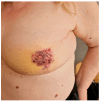Radiation-Induced Breast Angiosarcoma-A Single-Institution Experience
- PMID: 39451649
- PMCID: PMC11506978
- DOI: 10.3390/diagnostics14202326
Radiation-Induced Breast Angiosarcoma-A Single-Institution Experience
Abstract
Introduction: Radiation-induced breast angiosarcoma (RIBAS) is a rare adverse event associated with postoperative breast irradiation. The data from the literature indicate that RIBAS occurs in less than 0.3% of patients treated with adjuvant radiotherapy for breast cancer. Given the rarity, diverse clinical presentation, poor prognosis, and lack of consensus on the management, this study aimed to present experiences of our specialized cancer center with RIBAS, in terms of the incidence, presentation, management, and outcomes. Methods: We reviewed the medical records of 10,834 breast cancer patients treated at the Institute for Oncology and Radiology of Serbia between January 2013 and June 2024 to detect patients that had breast-conserving surgery, followed by postoperative irradiation, and developed angiosarcoma in the irradiated area at least 3 years after radiotherapy, without distant metastases. The incidence, latency period, management, and treatment outcomes were analyzed. Results: A total of nine female patients with RIBAS were identified and included in this study. The median age at RIBAS diagnosis was 64 years (range: 36-68), with a median latency of 64 months (95% CI > 57) from irradiation to diagnosis. The mean tumor size was 55 mm (SD 32.78). Patients were followed for a median of 30 months (range: 7-40) after initial RIBAS surgery. Local recurrence occurred in seven patients (77.8%), with five undergoing re-do surgery with curative intent. Three patients developed distant metastases during follow-up. The median overall survival (OS) was 31 months (95% CI > 30), with a 3-year survival rate of 15.2% (95% CI 2.5-91.6%). The median local recurrence-free interval was 10 months (95% CI > 3). Median OS after RIBAS local recurrence and after breast cancer treatment was 17 months (95% CI > 15) and 108 months (95% CI > 88), respectively. Conclusions: RIBAS is a rare but increasingly prevalent adverse event associated with BC irradiation, marked by an aggressive disease course and high relapse rates. Awareness, prompt diagnosis, and a radical surgical approach with wide clear margins are critical for improving patients' outcomes.
Keywords: angiosarcoma; breast cancer; irradiation/radiotherapy; prognosis; radiation induced; treatment.
Conflict of interest statement
The authors declare no conflicts of interest.
Figures




References
-
- Shaitelman S.F., Anderson B.M., Arthur D.W., Bazan J.G., Bellon J.R., Bradfield L., Coles C.E., Gerber N.K., Kathpal M., Kim L., et al. Partial Breast Irradiation for Patients with Early-Stage Invasive Breast Cancer or Ductal Carcinoma In Situ: An ASTRO Clinical Practice Guideline. Pract. Radiat. Oncol. 2023;14:112–132. doi: 10.1016/j.prro.2023.11.001. - DOI - PubMed
-
- Polgár C., Kahán Z., Ivanov O., Chorváth M., Ligačová A., Csejtei A., Gábor G., Landherr L., Mangel L., Mayer Á., et al. Radiotherapy of Breast Cancer—Professional Guideline 1st Central-Eastern European Professional Consensus Statement on Breast Cancer. Pathol. Oncol. Res. 2022;28:1610378. doi: 10.3389/pore.2022.1610378. - DOI - PMC - PubMed
-
- Mergancová J., Lierová A., Coufal O., Žatecký J., Melichar B., Zedníková I., Mergancová J., Jesenková A., Šťastný K., Gatěk J., et al. Radiation-associated angiosarcoma of the breast: An international multicenter analysis. Surg. Oncol. 2022;41:101726. doi: 10.1016/j.suronc.2022.101726. - DOI - PubMed
LinkOut - more resources
Full Text Sources

